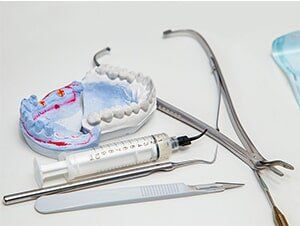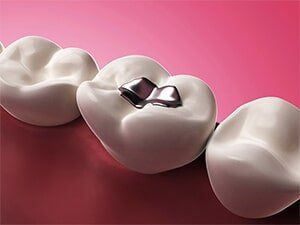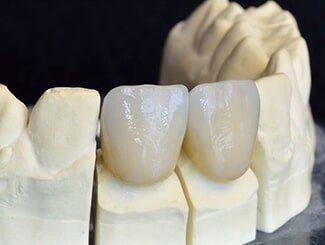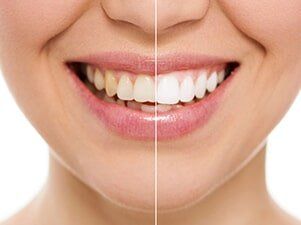GENERAL DENTISTRY MANSFIELD, ONTARIO & LEXINGTON,OH
Click on item for more detailed information
Dental Bridges

Dental bridges are natural-looking tooth replacements that help maintain facial structure, reduce stress on the jaw and fill in the gaps caused by missing teeth.
A dental bridge can be used to:
- Restore an attractive smile
- Reduce the risk of gum disease
- Restore the ability to bite and chew
- Improve speech
- Prevent remaining teeth from drifting out of position
Types of Dental Bridges
There are three main types of bridges:
Traditional Bridges
Also known as fixed bridges, traditional bridges are used to replace one or more missing teeth. The procedure involves creating a crown for the tooth or implant on either side of the missing tooth, with a pontic, or a false tooth, in between. Fixed bridges are the most common type of dental bridges and are either made out of porcelain fused to metal or out of ceramics.
Resin-Bonded Bridges
Also known as Maryland-bonded bridges, resin-bonded bridges are primarily used for the front teeth. They are less expensive than fixed bridges and are best for use when the teeth are healthy and do not have any large fillings. During this procedure, a false tooth is fused with resin to metal bands which are then bonded to the adjacent teeth and hidden from view. Resin-bonded bridges require only minimal preparation of the adjacent teeth.
Cantilever Bridges
These bridges are used in areas of the mouth that are under minimal stress, such as the back teeth. Cantilever bridges are recommended when there are teeth on only one side of the open space.
The Dental Bridge Procedure
There are several steps that are taken in order to create a bridge:
First Step
The adjacent teeth must be prepared. This involves removing some of the enamel to allow room for the crown to be placed over them.
Second Step
Impressions of the teeth are made. These will be sent to a laboratory so a bridge, a false tooth or pontic, and crowns can be created to fit the unique configuration of the patient's mouth. During the 2 to 3 weeks while the bridge is being manufactured, the patient will be given a temporary dental bridge to protect the exposed teeth and gums.
Third Step
During the next dental visit, the temporary bridge will be removed and replaced with the new, permanent bridge. The doctor will make sure the bridge fits properly and cement it to the teeth.
Recovery after a Dental Bridge Placement
Replacing missing teeth should make eating easier, but until they get used to the bridge, patients are advised to eat soft food cut into small pieces. For a few weeks after receiving a bridge, it is common to experience increased sensitivity to extreme temperatures. Patients will also notice a difference in their speech which will become clearer with the permanent bridge in place.
Results of a Dental Bridge Placement
With good oral hygiene, a dental bridge will last from 5 to 15 years, sometimes longer. Patients must remember to practice proper care of their teeth and gums to prevent the build-up of bacteria and formation of plaque. Regular dental visits and cleanings will still be required.
Tooth-Colored Fillings

In the past, dental cavities were filled with a mixture of metal alloys, also known as amalgam. Today, tooth-colored or composite fillings are a mixture of resin, glass or quartz and porcelain ceramics. These materials are resilient and long lasting. These fillings are colored to match the patient's teeth and are practically invisible to the untrained eye. For aesthetic and/or medical purposes, these tooth-colored fillings can be used to replace old and worn dental amalgam, gold or other metal fillings.
While composite fillings have visual advantages, over time they can become discolored. Just like metal fillings, tooth-colored fillings can be set and cured in one visit to the dentist.
Tooth-colored fillings are priced similarly to metallic alloy. They are not as long-lasting as amalgam fillings, and may chip in certain locations of the mouth. The dentist will discuss filling material options and recommend options based on the patient's medical and aesthetic needs.
Dental Crowns

A dental crown is a restoration that covers or caps a tooth, restoring it to its normal size and shape while strengthening and improving its appearance. Crowns are necessary when the tooth is broken down to the point where a filling will not be effective.
Benefits of Dental Crowns
A dental crown can be used for various reasons including covering discolored or misshapen teeth, and in conjunction with bridges and dental implants. Other benefits of dental crowns may include:
- Holding a cracked tooth together to prevent further damage
- Covering and supporting a tooth with a large filling
- Restoring a broken tooth
Dental Crown Procedure
The dental crown process takes place in two phases or appointments. At the first appointment, the tooth is prepared by filing or reshaping, so the crown can fit in securely and comfortably. The area around the tooth is numbed throughout the procedure with a local anesthetic. After the tooth is prepared, an impression is made of the teeth and gums using a paste or putty. The impression is then sent to a laboratory to make a custom crown, which usually takes two to three weeks. Patients are given a temporary dental crown until the permanent crown is ready.
At the second appointment, the new crown is inspected for proper fit and tooth color. The temporary crown is then removed and the new one is cemented onto the tooth.
Types of Dental Crowns
There are several different methods of crown restoration, each using a different crown material. Different types of crown material include:
Metal Crowns
Metal crowns are made entirely of a metal alloy that may include gold, platinum, palladium, or other elements. Compared with other kinds of crowns, metal crowns preserve more of the tooth structure. They withstand biting and chewing forces well and rarely chip or break. The biggest drawback of metal crowns is the metallic color.
Porcelain-Fused-To-Metal or PFM Crowns
PFM crowns can be color-matched to the teeth. Second only to all-ceramic crowns in appearance, porcelain-fused-to-metal crowns look like normal teeth. In some cases, the metal underlying the crown's porcelain can create a dark line. PFM crowns tend to wear down opposing teeth more than metal crowns. The crown's porcelain portion can also chip or break.
Resin Crowns
All resin crowns are the least expensive type of dental crown. The drawback is that they are more prone to chips and fractures than other crowns and tend to wear down over time.
Ceramic or Porcelain Crowns
These crowns provide the best natural color of all the dental crowns. They are not as strong as PFM or gold crowns, and they may wear down opposing teeth more than metal or resin crowns. Because they are the most cosmetically pleasing, they are commonly used for the front teeth.
Complications of Dental Crowns
Some patients experience increased sensitivity immediately after the procedure, particularly if the crowned tooth still has a nerve in it. For sensitivity to heat and cold, some patients are advised to use toothpaste for sensitive teeth. Other complications that may occur with dental crowns are:
Pain or Sensitivity When Biting
This usually means that the crown is too high on the tooth. If this is the case, the dentist will be able to fix the problem by adjusting the crown.
Chip In a Porcelain Crown
Resin can be used to repair the remaining crown. If the chipping is extensive, the entire crown may need to be replaced.
Loose Dental Crown
If the cement washes out from underneath the crown, bacteria can then leak in and cause decay. A dentist should be consulted to secure the crown to alleviate the problem.
In some cases, a dental crown may fall off entirely. If this happens, contact the dentist immediately. The dentist may be able to replace the crown or create a new crown if necessary.
With proper oral hygiene, dental crowns can last from five to fifteen years. Patients should consult with their dentist to see if dental crowns are appropriate for their individual condition.
Prophy and Root Planing
Scaling and root planing is a treatment usually performed during the early stages of periodontal disease to help remove plaque and tartar that has built up beneath the gum line. This procedure is considered a deep cleaning, and may be performed to prevent the disease from progressing to a more advanced stage, or to improve the quality of a patient's tissue before surgery.
The Scaling and Root Planing Procedure
During the scaling part of the procedure, an instrument called a scaler is used to scrape away any plaque or tartar that has built up beneath the gums. Plaque often develops in pockets that form between the teeth and gums. As the disease progresses, these pockets grow, which may cause teeth to loosen and eventually fall out.
After the scaler has removed the plaque and tartar, the treated area is rough and uneven. Root planing smooths the root of the tooth so that the gums can heal and reattach to the tooth properly. Anesthesia or sedation may be used during this procedure. Antibiotics or irrigation with antimicrobial may be prescribed to help prevent bacteria from growing in the mouth.
There is little-or-no pain associated with this procedure, and patients can resume their regular activities immediately afterward. Medication may be prescribed to address any post-treatment discomfort. After the scaling and root planing procedure, patients should practice proper oral hygiene in order to prevent pockets from reforming.
Dentures

Dentures are prosthetic devices designed to help patients with missing teeth, chew food, improve speaking habits, and improve the patient's facial aesthetics. The absence of teeth can lead to a sunken, collapsed appearance to the mouth-area. By restoring the physical presence of teeth, this malformation is corrected, the patient's mouth is supported and the appearance is improved by aesthetic standards.
Aesthetic dentures are custom crafted to provide a precise comfortable fit, and to enhance overall facial features. The color of the teeth is carefully selected and the natural differences in tooth shape and size are carefully chosen based on each individual's age, gender and unique facial qualities. In addition, dentures are made to replicate the gum tissue naturally while providing the proper structure and support for lips, cheeks and face.
Types of Dentures
There are three types of dentures:
Complete Dentures
Complete or full dentures are only required for people who have lost all or most of the teeth on either of the two arches of the mouth.
Fixed Partial Dentures
Most patients missing only a few teeth opt for fixed partial dentures, also known as “crown and bridge.” These must be precisely installed, especially when in between healthy teeth.
Removable Partial Dentures
Removable partial dentures are different from fixed partial dentures in that they are normally only used by people who have lost too many teeth for fixed dentures, but too few for full dentures.
Stability of Dentures
A frequent issue with dentures is their ability to remain in place during usage. This is based on the following factors:
Support
The denture may have a tendency to clasp tighter and tighter to the gums as the mouth chews food. The better the support, the less likely the denture is to move vertically closer to the arch upon which it is situated.
Stability
Movement in the horizontal plane sometimes described as “slipping” front to back or side to side, can be hazardous to the patient. The quality of a denture base is responsible for preventing movement and maintaining continuous contact with the gums. However, this is heavily dependent on the patient's oral anatomy.
Retention
Retention describes the tendency of the denture to move vertically away from the gums, into the lumen of the mouth. The craftsmanship of the denture is tested here, as the better the intaglio or the inside of denture, copies the oral topography, the more effective the seal is.
Maxillary dentures, used for the top teeth, achieve better unification with toothless gums due to the improvement in suction from the smooth surface. However, mandibular dentures, used for the bottom teeth, are much more effective if the patient still retains some teeth.
Partial Dentures
Partial dentures are prosthetic devices used to replace one or more missing or diseased teeth; restore the appearance and function of the teeth; or reduce the risk of gum disease. This type of replacement is often used when one or more healthy natural teeth remain in the area to support the denture. Patients are able to eat, speak and smile without difficulty once partial dentures are in place.
These devices may be fixed or removable, depending on the preference and oral health of the patient. Regardless of the type, partial dentures are precisely fitted to replace the missing teeth in a patient's mouth for improved comfort and functionality. Placement of partial dentures is performed by a dentist over a series of visits spaced several weeks apart.
Partial dentures require the same oral care, including twice-a-day brushing and regular cleanings, as natural teeth. Over time, partial dentures may require minor adjustments that can easily be made by a dentist.
Endodontics
Endodontics is a dental specialty that involves treatment of the inside of the tooth, known as the dental pulp. The pulp contains blood vessels, nerves and connective tissue to help form the outside of the tooth. Endodontic procedures are often needed when the pulp of the tooth becomes infected or inflamed, usually as a result of decay, repeated dental procedures or a crack or chip in the tooth.
Common types of endodontic procedures include:
Root Canal – The most common endodontic procedure is a root canal, which can diagnose and treat damage in the dental pulp.
Apicoectomy – Also known as root end resection, apicoectomy involves the removal of infected tissue and the end of the root.
Other types of endodontic procedures may be performed to treat more severe cases of pulp damage that have not responded to or recurred after initial treatment. A dentist will decide which procedure is right for each patient after a thorough evaluation of their condition.
Teeth Whitening
Teeth whitening or bleaching products brighten teeth that have been stained or darkened by food, tobacco use, age or injury. There are a variety of in-office and take-home teeth whitening products to reduce or eliminate such stains.

In-Office Teeth Whitening
In-office teeth whitening, also called chair-side bleaching, takes place during a series of appointments at a dentist's office. Advantages of in-office teeth whitening over take-home whitening include:
- Professional supervision
- Fast
- Safe and simple
- No sensitivity
Take-Home Teeth Whitening Products
Take-home bleaching solutions can help improve the color and overall brightness of teeth. These kits are simpler and less expensive than, and can be just as effective as, in-office treatments. Dentists provide patients with customized impression trays, whitening powder and whitening gel, the use of which improves the appearance of teeth over just a few days.
Over-The-Counter Teeth Whitening Products
Various over-the-counter products, such as whitening toothpastes and bleaching strips, are advertised as being effective teeth-whiteners. However, although based on the same science as professional bleaching, the concentration of effective ingredients tends to be much lower, lengthening treatment time and often not providing the level of whitening desired.
Whitening procedures are effective but not permanent. Depending on the procedure used, whitening may fade over time. Patients are advised to avoid food and drinks that may stain or darken teeth.
Some of the insurances that we offer are:
Aetna, Assurant, BC-BS, Cigna, Delta Dental, Guardian, Liberty Dental, Superior Dental, & United Concordia and many others.
Aetna, Assurant, BC-BS, Cigna, Delta Dental, Guardian, Liberty Dental, Superior Dental, & United Concordia and many others.






